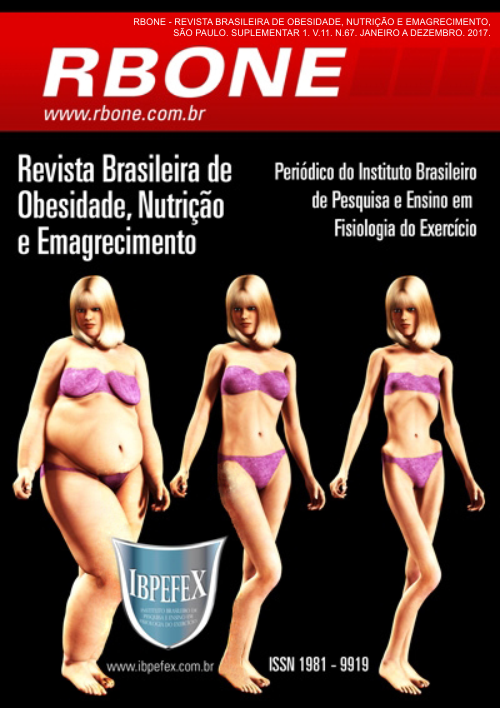Effects of resistance training personalized on body composition of adult men: a case study
Abstract
Introduction: in recent years resistance training (RT) has been used by many people, aiming at goals such as aesthetics, health and also sports performance. Aim: to evaluate the effect of 12 weeks of customized TR on body composition indicators. Materials and Methods: longitudinal case study. The sample, composed of 04 individuals, inactive with ages between 19 to 53. The anthropometric variables were measured to verify body composition before and after 12 weeks of training. The TR lasted for 12 weeks, in which the individuals had their training periodized and individualized. We used 2 to 4 sets of 8 to 15 submaximal and maximal repetitions, with intervals of 30 to 45 seconds between sets and 60 to 90 seconds between exercises. Results: the TR applied, generated significant changes in the increase of mass mass, perimetry of the thoracic, arms and thighs; Reduction of skinfold measurements in the abdominal and subscapular regions. It is concluded: that the personalized TR can generate significant changes in the anthropometric variables, skin folds and lean mass.
References
-Armstrong, L. ACSM's guidelines for exercise testing and prescription/American College of. Lippincott Williams & Wilkins.Philadelphia.2006.
-Arruda, D. P.; Assumpção, C. O.; Urtado, C. B.; Dorta, L. N. O.; Rosa, M. R. R.; Zabaglia, R.; Souza, T. M. F. Relação de Treinamento de força e peso corporal. Revista Brasileira de Prescrição e Fisiologia do Exercício. Vol. 4. Num. 24. p. 605-609. 2010. Disponível em: <http://www.rbpfex.com.br/index.php/rbpfex/article/view/291/293>
-Ciolac, E.G.; Guimarães, G. V. Exercício Físico e síndrome metabólica. Revista Brasileira de Medicina do Esporte. Vol. 10. Num. 4. p. 318-324. 2004.
-Foureaux, G.; Pinto, K. M. C.; Dâmaso, A. Efeito do consumo excessivo de oxigênio após exercício e da taxa metabólica de repouso no gasto energético. Revista Brasileira de Medicina do Esporte. Vol. 12. Num. 6. p. 393-398. 2006.
-Kraemer, W. J.; Adams, K.; Cafarelli, E.; Dudley, G. A.; Dooly, C.; Feigenbaum, M. S.; e colaboradores. American College of Sports Medicine position stand. Progression models in resistance training for healthy adults. Medicine and science in sports and exercise. Vol. 34. Num. 2. p. 364-380. 2002.
-Marfell, J.; e colaboradores. International standards for anthropometric assessment. ISAK. South Africa: Potchefstroom, 2006.
-Mccardle, D.; Katch, F.T; Katch, V.I. Fisiologia do exercício –Energia, Nutrição e Desempenho Humano, 7.ed. Guanabara Koogan, 2011.
-Montenegro, L. P. Musculação: Aspectos positivos para o emagrecimento. Revista Brasileira de Prescrição e Fisiologia do Exercício. Vol. 8. Num. 43. p. 100-105. 2014. Disponível em: <http://www.rbpfex.com.br/index.php/rbpfex/article/view/588/550>
-Nunes, F.B; Souza, E.N. Efeitos de 12 sessões de treinamento resistido na composição corporal: Um estudo de caso. Revista Brasileira de Prescrição e Fisiologia do Exercício. Vol. 8. Num. 49. p. 674-679. 2014. Disponível em: <http://www.rbpfex.com.br/index.php/rbpfex/article/view/677/641>
-Silva Filho, J.N. Objetivos de alunos que iniciaram a prática de exercícios físicos numa academia de Porto Velho-RO: Estudo Transversal. Revista Centro de Pesquisas Avançadas em Qualidade de Vida. Vol. 7. Num. 1. p. 1-9. 2015.
-Silva Filho, J.N. Treinamento de força e seus benefícios voltados para um emagrecimento saudável. Revista Brasileira de Prescrição e Fisiologia do Exercício. Vol. 7. Num. 40. 2013. Disponível em: <http://www.rbpfex.com.br/index.php/rbpfex/article/view/525/499>
-Silva Filho, J.N; Ferreira, R.A. Número de repetições utilizadas no treino de força para o emagrecimento: uma revisão sistemática. Revista Brasileira de Prescrição e Fisiologia do Exercício. Vol. 8. Num. 49. p. 705-711. 2014. Disponível em: <http://www.rbpfex.com.br/index.php/rbpfex/article/view/687/645>
-Silva Filho, J.N.; Cordeiro, R. C. F. S. C.; Cruz, A. P.; Godoi Filho, J. R. M.; Saraiva, B.; Ferreira, R. A. Efeitos do exercício físico de força sobre o desenvolvimento ósseo em crianças e adolescentes: uma revisão sistemática. Revista Brasileira de Prescrição e Fisiologia do Exercício. Vol. 9. Num. 51. p. 40-47. 2015. Disponível em: <http://www.rbpfex.com.br/index.php/rbpfex/article/view/716/671>
-Silva Filho, J. N.; e colaboradores. Shadow Moiré technique for postural assessment: qualitative assessment protocol by intra-and inter-rater evaluation. Journal of Physical Therapy Science. Vol. 29. Num. 2. p. 356-360. 2017.
-Thomas, J. R.; Nelson, J. K.; Silverman, S. J. Métodos de Pesquisa em Atividade Física. Porto Alegre: Artmed, 2012.
-Winett, R.A.; Carpinelli, E.D. Potential health-related benefits of resistance training. Preventive Medicine. Vol. 33. p. 503-513. 2001.
-Yin, R.K. Estudo de caso: planejamento e métodos. 2ª edição. Porto Alegre. Bookmam. 2001.
Authors who publish in this journal agree to the following terms:
- Authors retain the copyright and grant the journal the right of first publication, with work simultaneously licensed under the Creative Commons Attribution License BY-NC which allows the sharing of the work with acknowledgment of the authorship of the work and initial publication in this journal.
- Authors are authorized to enter into additional contracts separately for non-exclusive distribution of the version of the work published in this journal (eg, publishing in institutional repository or book chapter), with acknowledgment of authorship and initial publication in this journal.
- Authors are allowed and encouraged to post and distribute their work online (eg, in institutional repositories or on their personal page) at any point before or during the editorial process, as this can bring about productive change as well as increase impact and impact. citation of published work (See The Effect of Free Access).






